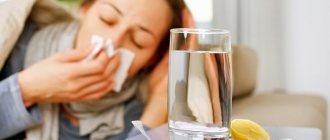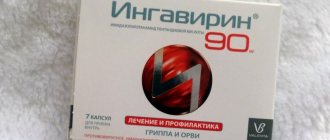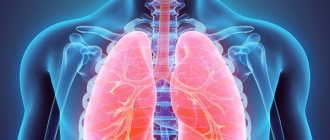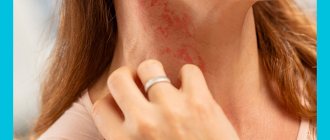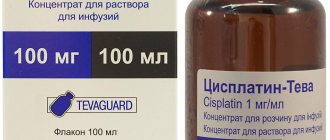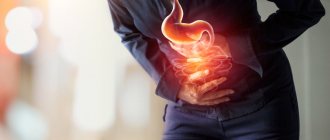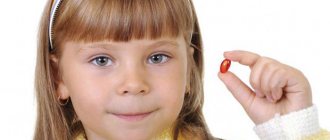Release form and composition
Dosage form - granulated powder for the preparation of a solution for oral administration: pink in color of varying intensity with white and dark pink inclusions, with raspberry flavor (3 g in multi-layer sachets, in a cardboard pack of 5 or 10 sachets and instructions for use of Rinzasip for children) .
Composition of the drug per 1 sachet:
- active ingredients: paracetamol – 280 mg, ascorbic acid – 100 mg, pheniramine maleate – 10 mg;
- auxiliary components: raspberry flavor Permasil 11036-31, sucrose, acesulfame potassium, aspartame, magnesium citrate, azorubine red dye.
Pharmacological properties
Pharmacodynamics
The effect of the combined drug Rinzasip for children is due to the properties of its active ingredients:
- paracetamol (analgesic non-narcotic drug) is an antipyretic and analgesic that reduces elevated body temperature and reduces the pain syndrome accompanying colds (headache, joint and muscle pain, sore throat);
- ascorbic acid (vitamin) – an antioxidant involved in the regulation of carbohydrate metabolism, redox processes and blood clotting, in the synthesis of steroid hormones and tissue regeneration; reduces vascular permeability, enhances the body's resistance to the adverse effects of various environmental factors;
- pheniramine (H1-histamine receptor blocker) is an antiallergic drug that eliminates symptoms typical of a cold, such as itching in the eyes, nose and throat, swelling and hyperemia of the nasal mucosa, paranasal sinuses and nasopharynx, exudative manifestations (lacrimation, rhinorrhea).
Pharmacokinetics
From the gastrointestinal tract (GIT), paracetamol is absorbed quickly and almost completely. The maximum plasma concentration (Cmax) is observed 10–60 minutes after taking the drug. The drug substance is distributed in most tissues of the body, including penetrating the placental barrier and into breast milk. When used in therapeutic doses, it is slightly bound to plasma proteins, but binding increases with increasing concentration. The primary metabolism of paracetamol occurs in the liver. It is excreted from the body mainly in the form of sulfates and glucuronides through the kidneys. Half-life (T1/2) – 1–3 hours.
Ascorbic acid is completely and quickly absorbed in the gastrointestinal tract. 25% binds to plasma proteins. Excreted in urine in the form of metabolites. In case of taking excessive doses, it is excreted quickly unchanged.
Pheniramine reaches Cmax within 1–2.5 hours. About 70–80% of the dose is excreted unchanged or in the form of metabolites in the urine. T1/2 is 16–19 hours.
Composition of the medicinal product
Rinzasip is produced in powder form for children and adults. The main active ingredients included in its composition are: paracetamol, caffeine, citric acid, phenylephrine, pheniramine.
- Paracetamol is an analgesic and antipyretic that quickly relieves the symptoms of colds, namely: headaches, sore throat, while simultaneously lowering body temperature. During pregnancy, it is undesirable for this component to enter the woman’s body.
- Phenylephrine helps counteract swelling and redness in the lining of the upper respiratory tract and sinuses.
- Pheniramine helps to get rid of signs of hypersensitivity, that is, it relieves itching of the nose and eyes, reduces swelling and redness of the affected nasopharyngeal mucosa, and normalizes blood clotting.
- Caffeine stimulates the functioning of the central nervous system, which helps overcome fatigue and loss of strength, improves mental activity of the brain and normalizes the body's physical performance.
- Citric acid is involved in the activation and normal course of redox processes, carbohydrate metabolism, and also helps to activate the processes of restoration of damaged tissues. It reduces the degree of permeability of vascular walls, thereby improving the functioning of the immune system, weakened due to the negative influence of external factors.
The powder for preparing the solution may contain different flavoring additives:
- Orange. After dissolving in water, it acquires a shade from light orange to orange with white splashes, and has a pronounced orange taste.
- Citric. The color after dissolution is from light yellow to yellow, also with white patches, and has a lemon flavor.
- Blackcurrant. After dissolution, it acquires a pink or reddish tint and is distinguished by the taste of black currant.
The drug is available in a cardboard box of 5, 10, 50 or 100 sachets. It is strictly forbidden to take it during pregnancy.
Contraindications
Absolute:
- age up to 6 years;
- period of pregnancy and lactation;
- glucose-galactose malabsorption;
- fructose intolerance;
- sucrase/isomaltase deficiency;
- phenylketonuria;
- deficiency of the enzyme glucose-6-phosphate dehydrogenase;
- blood diseases;
- severe liver/kidney dysfunction;
- portal hypertension;
- alcoholism;
- hypersensitivity to any active or auxiliary component of the drug.
Relative (Rinzasip for children should be used with caution):
- congenital hyperbilirubinemia (Dubin-Johnson, Gilbert or Rotor syndromes);
- difficulty urinating;
- Chronical bronchitis;
- bronchial asthma;
- pyloroduodenal obstruction;
- stenosing ulcer of the stomach and/or duodenum;
- emphysema;
- diabetes;
- concomitant use of tricyclic antidepressants or monoamine oxidase inhibitors (MAO);
- simultaneous use of drugs with a potential negative effect on the liver (carbamazepine, isoniazid, rifampicin, phenytoin, zidovudine, phenobarbital, barbiturates and other inducers of microsomal liver enzymes).
Side effects
Using the drug for a long time can provoke the development of negative manifestations from various body systems.
Side effects:
Before using the medicine, it is very important to study the instructions for the compatibility of other pharmaceuticals with Rinzasip. Drug interactions:
Drug interactions:
- enhancing the effect of ethanol, sedatives, monoamine oxidase inhibitors;
- increased risk of developing adverse reactions when using drugs against Parkinson's disease, antipsychotic compounds, antidepressants, phenothiazine derivatives;
- combination with glucocorticosteroids increases the risk of glaucoma;
- the use of Rinzasip and diuretics reduces the effectiveness of the latter;
- the hepatotoxic effect of paracetamol increases if a person simultaneously takes carbamazepine, rifampicin, barbiturates, diphenin;
- the antihypertensive effect of Guanethidine will be reduced;
- Guanethidine may increase the stimulant effect produced by phenylephrine hydrochloride;
- combined use of Halothane may provoke the development of ventricular arrhythmia;
- tricyclic antidepressants enhance the adrenomimetic effect of phenylephrine hydrochloride.
Rinzasip for children, instructions for use: method and dosage
A solution is prepared from granulated Rinzasip powder for children: 1 sachet per glass (200 ml) of warm water. The drug is taken orally.
Recommended quantity of sachets for children of different ages:
- 6–10 years – 1 sachet 2 times a day;
- 10–12 years – 1 sachet 3 times a day;
- 12–15 years – 1 sachet 4 times a day.
The minimum acceptable interval between doses is 4 hours.
Treatment with the drug is carried out for no more than 5 days.
Side effects
When taking Rinzasip for children, the following adverse reactions may develop:
- from the digestive system: dryness of the oral mucosa, pain in the epigastric region, nausea, vomiting, hepatotoxic symptoms;
- from the urinary system: difficulty urinating, nephrotoxic manifestations (interstitial nephritis, glycosuria, renal colic, papillary necrosis);
- from the senses: paresis of accommodation, mydriasis, increased intraocular pressure;
- from the nervous system: difficulty falling asleep, drowsiness, headache, increased excitability, dizziness;
- from the hematopoietic organs: agranulocytosis, thrombocytopenia, leukopenia, pancytopenia, methemoglobinemia, anemia (including aplastic and hemolytic);
- allergic reactions: urticaria and other skin rashes, skin itching, anaphylactic shock, angioedema;
- other: bronchospasm.
In very rare cases, the following serious skin reactions occur while taking Rinzasip for children:
- Stevens-Johnson syndrome (erythema malignant exudative): a severe form of erythema multiforme, accompanied by the appearance of blisters on the skin and mucous membranes, including the eyes, mouth, throat and genitals;
- acute generalized exanthematous pustulosis: an acute condition manifested by fever, the appearance of a pustular rash, diffuse erythema with burning and itching, sometimes accompanied by swelling of the mucous membranes, face and hands;
- toxic epidermal necrolysis (Lyell's syndrome): severe allergic bullous dermatitis, resulting from extensive death of epithelial tissue cells (keratinocytes) and leading to detachment of large areas of skin at the dermoepidermal junction (externally, the skin looks like it has been scalded with boiling water).
Overdose
In case of overdose of Rinzasip for children, you should urgently call a doctor. Prompt first aid is critical, even in the absence of any symptoms of intoxication.
Symptoms of pheniramine overdose: impaired consciousness, convulsions, coma.
In children under 12 years of age, acute overdose of paracetamol is possible when taken ≤ 0.15 g/kg; it is not associated with hepatotoxicity. In adolescents over 12 years of age and adults, overdose symptoms occur within 8 hours after taking paracetamol in a dose of more than 7.5 g. Deaths are possible in the absence of medical care after taking a dose of 15 g or more, and are rare (< 3–4% of patients, who have not received appropriate treatment).
It should be taken into account that the sensitivity threshold to paracetamol may be reduced in children, as well as in some patients due to exhaustion, alcohol consumption or taking certain medications (for example, inducers of microsomal liver enzymes).
Symptoms that occur in the first 24 hours after taking an excessive dose of the drug: increased sweating, general malaise, pale skin, abdominal pain, nausea, vomiting.
After 12–48–72 hours, signs of functional liver disorder may develop: increased activity of liver enzymes, hepatonecrosis. In case of severe intoxication, liver failure, progressive encephalopathy, and coma are possible. In rare cases, liver failure has a fulminant course and is complicated by renal failure (tubular necrosis).
It is expected that acute liver failure may lead to the following clinical disorders: gastrointestinal bleeding, pancreatitis, lactic acidosis, metabolic acidosis, hypoglycemia, respiratory failure, coagulopathies, disseminated intravascular coagulation, thrombocytopenia, bacterial/fungal infection, sepsis, encephalopathy, cerebral edema, arterial hypotension, cardiomyopathy, multiple organ failure, coma. The rapid development of liver failure or its consequences can be fatal.
The patient's stomach is first washed. If no more than 6 hours have passed since taking the drug, taking activated carbon is indicated. After 8–9 hours, donors of SH groups and precursors for the synthesis of glutathione (methionine) are introduced, after 12 hours, acetylcysteine is introduced. Additional medical measures (the need for subsequent administration of methionine and acetylcysteine) are determined individually after determining the concentration of paracetamol in the blood, and also depending on the period that has passed since taking the drug. To eliminate the negative manifestations of an overdose, symptomatic therapy is carried out.
Risks of drug overdose
An overdose of Rinzasip occurs mainly due to paracetamol in its composition. When consuming more than 15 g of this substance, the skin may turn pale, nausea with vomiting, and loss of appetite may occur. To rid a person of such manifestations, he needs a gastric lavage procedure and the intake of enterosorbents. Cases of overdose are quite rare, which is why reviews of the drug Rinzasip are often positive.
special instructions
Rinzasip for children should not be taken together with other drugs that contain paracetamol.
During treatment with the drug, peripheral blood counts, kidney and liver conditions should be monitored.
Rinzasip powder for children contains sucrose: 1 sachet contains 2361.7 mg, which is equivalent to 0.2 bread units. This should be taken into account when treating children with diabetes and patients on a hypocaloric diet.
In persons receiving paracetamol, plasma glucose or uric acid levels should not be tested, since the drug will distort the results.
If symptoms of the disease persist or worsen after 5 days of taking Rinzasip for children, you should consult a doctor.
Impact on the ability to drive vehicles and complex mechanisms
The drug may cause drowsiness, which should be taken into account during activities that require increased attention and speed of reactions.
RINZASIP (powder)
mobile
If you are sick, then sit at home, why wander around, or infect your colleagues with bacilli. What is the advantage of Rinzasip, because there is cheap paracetamol. Perhaps I will not focus only on the complex of ingredients of Rinza powder, paracetamol and ascorbic acid, everyone already knows their effect, but phenylephrine hydrochloride is interesting, it constricts blood vessels and, at least a little, helps fight the runny nose.
And the substance pheniramine maleate, of course, not everything is so simple with it, on the one hand, it suppresses sneezing and also reduces nasal congestion, on the other hand, because of it you can’t drive, as it causes drowsiness. But the cunning Johnson and his Johnson managed to get out of this too, adding caffeine to the composition, in theory it should balance the effect of pheniramine.
In general, it must be said that similar products from competitors, such as Coldrex, Theraflu and some others, contain phenylephrine hydrochloride, but Coldrex may be more useful for drivers, since it does not contain the sleepy pheniramine maleate, although it contains an expectorant terpinhydrate, which is also not without side effects, vomiting and allergies are possible, although this is increasingly a reinsurance of the manufacturers, since I personally have never noticed it on myself when taking such drugs, it’s all a matter of doses.
There are only 5 sachets of Rinzasip powder in my box, but they are also available in other packaging. I don’t get sick that often, and I don’t take the drug in huge doses, no more than two sachets a day out of a possible four for my age.
Now I have the taste of currant in my medicine cabinet, of course I can’t call it tasty, but it’s a little better than orange, in my opinion.
Adding sugar or honey to Rinzasip, in my opinion, does not improve its taste at all; children with a sweet tooth, of course, can and will find it more enjoyable in this form, but for children, judging by the information from the package, only from the age of 15, well, what kind of children are they? That. About younger ages they are simply silent.
Cons: — The pheniramine maleate component is not entirely suitable for drivers. (personally, Rinzasip does not make me drowsy) - To put it mildly, I’m not delighted with the taste, like currant Rinzasip, orange and whatever else... - In theory, simple and cheap paracetamol helps me no worse, but I understand that the complex of drugs still works a little better, especially since I don’t think it would occur to anyone to buy the active ingredients separately.
I recommend it, and on my own behalf I give it five stars, since no drug causes any side effects for me, so I warned you just in case. The price could have been less, of course, I don’t remember exactly how much I bought it for, but something like 200 rubles.
Drug interactions
- uricosuric drugs: under the influence of paracetamol their effect is reduced;
- glucocorticosteroids: the risk of glaucoma increases;
- microsomal oxidation inhibitors (for example, cimetidine): the likelihood of developing the hepatotoxic effect of paracetamol is reduced;
- ethanol, inducers of microsomal liver enzymes (including isoniazid, carbamazepine, phenytoin, barbiturates, zidovudine, rifampicin): the hepatotoxic effect of paracetamol increases;
- ethanol, sedatives, MAO inhibitors: their effect is enhanced;
- cardiac glycosides (including digoxin): arrhythmia may develop, the risk of myocardial infarction increases;
- indirect anticoagulants (warfarin and other coumarin derivatives): with occasional use of paracetamol, the international normalized ratio does not change, however, with prolonged use, the effect of these drugs increases and the risk of bleeding increases;
- salicylates: increased nephrotoxic effect;
- chloramphenicol: its half-life increases;
- antipsychotics (phenothiazine derivatives), antiparkinsonian drugs, antidepressants: the sedative effect increases, there is a risk of dry oral mucosa, urinary retention and constipation;
- other drugs with anticholinergic properties (atropine-like antispasmodics, phenothiazine neuroleptics, antihistamines): central atropine-like effects are enhanced.
Analogs
Rinza has many analogues, including more budget or expensive ones.
Here is a list of cheap analogues:
- Paracetamol (40 rub.);
- Acetylsalicylic acid (30 rub.);
- Ibuprofen (50 rub.);
- Antigrippin (40 rub.);
- Citrapak (59 RUR) etc.
What is the cost?
The price of Rinza tablets varies from 80 rubles. per package, almost as much as the cost of drugs (including powders) with a similar composition. A package of Rinzasip (10 powders) costs almost one and a half times more.
Reviews of Rinzasip for children
Parents who have used the drug to treat children leave mostly positive reviews about Rinzasip for children. They note that when taking the drug, unpleasant cold symptoms are effectively eliminated: headache, rhinorrhea, fever, nasal congestion. The effect of the drug develops quickly. The prepared solution has a raspberry taste, which, however, not all children like. The powder is relatively inexpensive.
Among the disadvantages, they indicate the content of dye in the composition, the presence of a large list of contraindications and possible side effects. In isolated cases, there are complaints about the lack of effect from taking Rinzasip for children.
General information about the drug
Cold powder is characterized by thermoregulatory, analgesic, vasoconstrictor and antihistamine effects. It quickly and effectively relieves the symptoms of ARVI, helps to increase the tone of the vascular walls. Since the combination drug contains several main components, it has a wider spectrum of action.
Drug group, INN, scope of application
The drug is a representative of a pharmacological group consisting of medications intended for the symptomatic elimination of signs of colds and ARV infections. Manufacturers used caffeine, paracetamol, phenylephrine hydrochloride and pheniramine maleate as basic active ingredients. These components determine the mechanism of action of the cold powder.
Compound
The effectiveness of the powder is explained by its combined composition. The mechanism of action of the drug is provided by 4 components at once:
- Caffeine (30 mg). Helps improve performance, stimulates the active functioning of the central nervous system.
- Paracetamol (750 mg). An analgesic with a pain-relieving effect. Relieves hyperthermia, eliminates aches in joints and muscles during the development of viral diseases.
- Phenylephrine hydrochloride (10 mg) is an alpha adrenergic agonist. Eliminates nasal swelling, normalizes blood pressure. With prolonged use, the body gets used to the substance, so dosage adjustment may be necessary.
- Pheniramine maleate (20 mg). The substance helps block H1 histamine receptors. Eliminates bronchospasms. Has a mild sedative effect.
A list of additional components was used in the production process: sodium citrate, citric acid, sucrose, dyes and flavorings.
Pharmaco-properties
The main advantage of the drug is that it has a complex antipyretic and analgesic effect:
- Paracetamol temporarily reduces the activity of the thermoregulatory and pain centers.
- Phenylephrine relieves hyperemia and swelling of the mucous membranes, which allows you to clear the paranasal sinuses and restore normal breathing.
- Under the influence of caffeine, the overall tone of the body increases. The patient feels a surge of strength.
- Also, the medication slows down the intensity of the process of mucus secretion in the nasopharynx/bronchial tubes.
The substances contained in the drug do not have a negative effect on the gastrointestinal tract. Taking the medicine does not lead to disruption of water and electrolyte balance.
Absorption of substances occurs in the intestines. They are characterized by a fairly high degree of binding to plasma proteins. After 40-60 minutes, the peak amount of components in the plasma is recorded. Excretion from the body is carried out through the kidneys (with urine).
